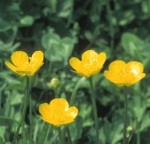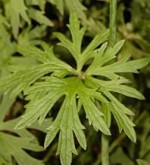 Tall buttercup is a perennial weed native to central and northeastern Europe and is now found in most of the United States where it is considered a noxious weed in Montana and Minnesota. It thrives in moist soil with full sun to part shade and can be found in a variety of habitats including wet lowlands, rich woodlands, moist pastures and meadows, and along roadsides. It invades lawns and flowerbeds where it looks beguilingly attractive in spring when it blooms. Also known as blister plant because it contains an oil that irritates and blisters the mouth of grazing animals but is usually avoided by them due to its unappealing taste.
Tall buttercup is a perennial weed native to central and northeastern Europe and is now found in most of the United States where it is considered a noxious weed in Montana and Minnesota. It thrives in moist soil with full sun to part shade and can be found in a variety of habitats including wet lowlands, rich woodlands, moist pastures and meadows, and along roadsides. It invades lawns and flowerbeds where it looks beguilingly attractive in spring when it blooms. Also known as blister plant because it contains an oil that irritates and blisters the mouth of grazing animals but is usually avoided by them due to its unappealing taste.

 Description: The first winter or spring tall buttercup forms rosettes of lobed leaves, followed by several erect, hairy, hollow stems that are branched in the top half and grow 1’ to 3 1/2’ tall. The basal leaves are hairy, 4-6” long, and palmately divided into 3-5 lobes with each lobe being further divided and coarsely toothed. Stem leaves are alternate, smaller and have fewer lobes and teeth as they ascend. In spring the tops of the stems produce branched clusters of yellow flowers 1” wide with 5-7 petals. Flowering may continue well into the summer with flowers producing spherical seed heads bearing reddish-brown, flattened ovate seeds about 1/8” long and bearing a short hook. The root system is fibrous and may include rhizomes.
Description: The first winter or spring tall buttercup forms rosettes of lobed leaves, followed by several erect, hairy, hollow stems that are branched in the top half and grow 1’ to 3 1/2’ tall. The basal leaves are hairy, 4-6” long, and palmately divided into 3-5 lobes with each lobe being further divided and coarsely toothed. Stem leaves are alternate, smaller and have fewer lobes and teeth as they ascend. In spring the tops of the stems produce branched clusters of yellow flowers 1” wide with 5-7 petals. Flowering may continue well into the summer with flowers producing spherical seed heads bearing reddish-brown, flattened ovate seeds about 1/8” long and bearing a short hook. The root system is fibrous and may include rhizomes.

 Control: Hand pulling is spring or early summer when soil is moist is effective but care must be taken to remove the entire root so that root fragments left behind do not produce more plants. As the plants age the roots grow less flexible and are difficult to pull up intact so early removal is essential. Since the primary mode of reproduction is seed, removing flowers before they set seed is important to reduce new plants the following year. Soil improvement measures such as adding lime and improving drainage aids in reducing the establishment of tall buttercup but will not be effective against well-established plants. Tall buttercup does not tolerate cultivation so plowing may be useful for large areas. Herbicides with MCPA are the most effective means of chemical control but glyphosate can also be used.
Control: Hand pulling is spring or early summer when soil is moist is effective but care must be taken to remove the entire root so that root fragments left behind do not produce more plants. As the plants age the roots grow less flexible and are difficult to pull up intact so early removal is essential. Since the primary mode of reproduction is seed, removing flowers before they set seed is important to reduce new plants the following year. Soil improvement measures such as adding lime and improving drainage aids in reducing the establishment of tall buttercup but will not be effective against well-established plants. Tall buttercup does not tolerate cultivation so plowing may be useful for large areas. Herbicides with MCPA are the most effective means of chemical control but glyphosate can also be used.